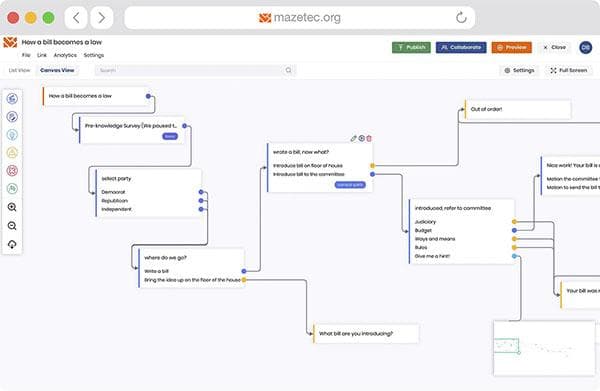Quick Summary:
- Constructivism is a theory based on scientific study on how people learn.
- We actively create our own knowledge.
- Constructivism concentrates on learning how to think and understand.
- Learning is active, not passive.
- People produce knowledge and form meaning based upon their experiences.
- Mazetec enables you to create online active learning experiences
Constructivism is one of those effective teaching approaches that has waxed and waned over the years, but it was never able to make the leap to online learning. There are different more narrow implementations of it such as Problem-based learning, Project-based learning, and more recently Scenario-Based learning.
For the practitioner, it’s not helpful to know that it’s a pedagogical philosophy, however, at its core it’s Learning by Doing. That is merely the end-result, the question is: how do we get there?
Constructivism is a reverse engineering of trial-and-error, as the student practices a new skill such as playing the piano or manipulating a new piece of knowledge in their mind to make an informed decision. During these mental gymnastics the student is actively constructing that knowledge in their mind’s eye and manipulating it in their working memory to solve the problem presented to them. They discover and transform information, check new information against old, and revise rules when they no longer apply.
The point of constructivism is to tap into the learner's innate curiosity about how things work. Learners do not reinvent the wheel but, rather, attempt to understand how it turns, how it functions.
As learners perceive each new experience, they will continually update their own mental models to reflect the new information, and will, therefore, revise their interpretation of reality.
But of course if it were that easy, then we wouldn’t have spent years researching, building, and testing the Mazetec platform designed for this very purpose.
How does it work for the learner?
Learners confront their understanding in light of what they encounter in the new learning situation. If what learners encounter is inconsistent with their current understanding, their understanding can change to accommodate new experience.
- The constructivism learning theory argues that people produce knowledge and form meaning based upon their experiences.
- Knowledge can only exist within the human mind and it does not have to match any real world reality.
As an instructor, how can I apply constructivism to online learning?
We can cite article after article detailing active teaching and learning techniques, but in the Mazetec way. I’ll give you a choice.
The hard way
Forge your own path, research active learning techniques such as experiments, projects, or real-world problem solving challenges to initiate the knowledge absorption and construction. Design your instruction and also build into the task the point at which you and the learner can reflect on the tasks within the activity and talk about what they are doing and how their understanding is changing. As an instructor you need to make sure each learner understands the pre-existing conceptions, and guide the activity to address the lessons with the activity so the learners can build upon them.
The Mazetec way
With a focus on learning outcomes, we’ve built the constructivist platform for you and added a lot more including the state dependent and emotional components of learning.
- Sign-up, it’s free during the beta.
- Start with a specific problem.
- See How to Create a Problem-Based Scenario for a full guide.

How do I measure scenario based learning online?
Learning outcomes should focus on the knowledge construction process and that learning goals should be determined from authentic tasks with specific objectives.
If you choose the hard way, your guess is probably the same as mine.
However, the Mazetec way comes with a fully customizable analytics platform that allows you to ask your own questions of the data. We capture everything including the elusive learner abandonment. Gain insight into why learners suddenly quit an activity including type of abandonment, the exact time, and location within the scenario, and if they returned.

Basic characteristics of Constructivist Learning Environments
Mazetec meets Tam’s list of basic characteristics for a constructivist learning environments, which must be considered when implementing constructivist instructional strategies:
- Knowledge will be shared between teachers and students.
- Teachers and students will share authority.
- The teacher's role is one of a facilitator or guide.
- Learning groups will consist of small numbers of heterogeneous students.
Pedagogical Goals of Constructivist Learning Environments
Mazetec also satisfies Honebein’s seven pedagogical goals of constructivist learning environments as:
- Provides experience with the knowledge construction process (students determine how they will learn).
- Provides experience in and appreciation for multiple perspectives (evaluation of alternative solutions).
- Embeds learning in realistic contexts (authentic tasks).
- Encourages ownership and a voice in the learning process (student centered learning).
- Embeds learning in social experience (collaboration).
- Enables the use of multiple modes of representation, (video, audio text, etc.)
- Encourage awareness of the knowledge construction process (reflection, metacognition).
Benefits of Constructivism
- People learn more, and enjoy learning more when they are actively involved, rather than passive listeners. Lectures are what parents do to naughty children. They just don’t work.
- Focuses on thinking and understanding, rather than on rote memorization. Constructivism concentrates on learning how to think and understand.
- Constructivist learning is transferable. In constructivist classrooms, students create organizing principles that they can take with them to other learning settings.
- Constructivism gives students ownership of what they learn, since learning is based on students' questions and explorations, and often the students have a hand in designing the assessments as well. Constructivist assessment engages the students' initiatives and personal investments in their journals, research reports, physical models, and artistic representations. Engaging the creative instincts develops students' abilities to express knowledge through a variety of ways. The students are also more likely to retain and transfer the new knowledge to real life.
- By grounding learning activities in an authentic, real-world context, constructivism stimulates and engages students. Students in constructivist classrooms learn to question things and to apply their natural curiosity to the world.
- Constructivism promotes social and communication skills by creating a classroom environment that emphasizes collaboration and exchange of ideas. Students must learn how to articulate their ideas clearly as well as to collaborate on tasks effectively by sharing in group projects. Students must therefore exchange ideas and so must learn to "negotiate" with others and to evaluate their contributions in a socially acceptable manner. This is essential to success in the real world, since they will always be exposed to a variety of experiences in which they will have to cooperate and navigate among the ideas of others.
Constructivism Learning Theory: A Paradigm for Teaching and Learning
Abstract: Constructivism represents one of the big ideas in education. Its implications for how teachers teach and learn to teach are enormous. If our efforts in reforming education for all students are to succeed, then we must focus on students. To date, a focus on student-centered learning may well be the most important contribution of constructivism. This article, therefore, discusses constructivism learning theory as a paradigm for teaching and learning. Constructivism is a learning theory found in psychology which explains how people might acquire knowledge and learn. It therefore has direct application to education. The theory suggests that humans construct knowledge and meaning from their experiences. Conceptual understanding of the theory was discussed as well as basic characteristics of constructivists learning environment. Seven pedagogical goals of constructivist learning environments and six benefits of constructivism were outlined in this article. Significant differences between traditional classroom and constructivist classroom were spelt out in a tabular form. Furthermore,principles of constructivism and several implications of constructivism for teaching and learning were reviewed. The study, therefore, concluded that teachers need to reflect on their practice in order to apply these ideas to their work and that constructivist teachers encourage students to constantly assess how the activity is helping them gain understanding.